This post may contain affiliate links. If you click through a link and make a purchase, I may receive a commission at no additional cost to you. As an Amazon Associate, I earn from qualifying purchases. Read the full disclosure here.
Pain is a complex issue. While we’d all love a few magic stretches, the truth is, the puzzle is much more complicated.
Did you know that deep breathing can be a crucial piece to tackling back pain? That’s right; these simple and accessible techniques can help to rebalance your system and decrease pain.
Stick around to learn how the science of breathing can be a natural hack into pain relief and easy exercises you can start using right away.
Disclaimer: This content is for educational purposes and is not medical advice. Read the full disclaimer.
Important concepts in pain
Pain is a complex physical, psychological, and emotional process with environmental factors experienced individually.
The bottom line, your pain is real, and we’re all different.
As easy as it is to recommend a few exercises and send you on your way, I’d be doing you a massive disservice if I didn’t back up and break down some of the behind-the-scenes aspects of pain.
Pain isn’t a signal coming from a particular body part but rather an interpretation from the central nervous system that includes multiple factors.
An interesting finding is that pain frequently doesn’t match up with the amount of tissue damage, leaving patients frustrated and confused when their MRI doesn’t explain the cause of their pain, suggesting there’s much more to the puzzle.
Though this article uses low back pain as an example, these techniques can be used for any type of pain.
I’m also not here to tell you breathing is the only thing you’ll ever need because that’s just silly. Breathing is super important and should be on everyone’s radar, but is only be a piece of an overall pain management or rehabilitation program.
Breathing and the nervous system
Breathing is normally involuntary, as we don’t forget to breathe just because we’re not thinking about it. However, we can exercise some control over the pace and depth of our breathing.
Sympathetic and parasympathetic nervous system
The autonomic nervous system is part of the peripheral nervous system (outside of the brain and spinal cord) that regulates involuntary processes like heart rate, respiration, digestion, etc.
Within the autonomic nervous system, there are the sympathetic and parasympathetic nervous systems.
The sympathetic system is your fight-flight response, funneling energy to the most vital processes at that time. The parasympathetic system covers rest and digest.
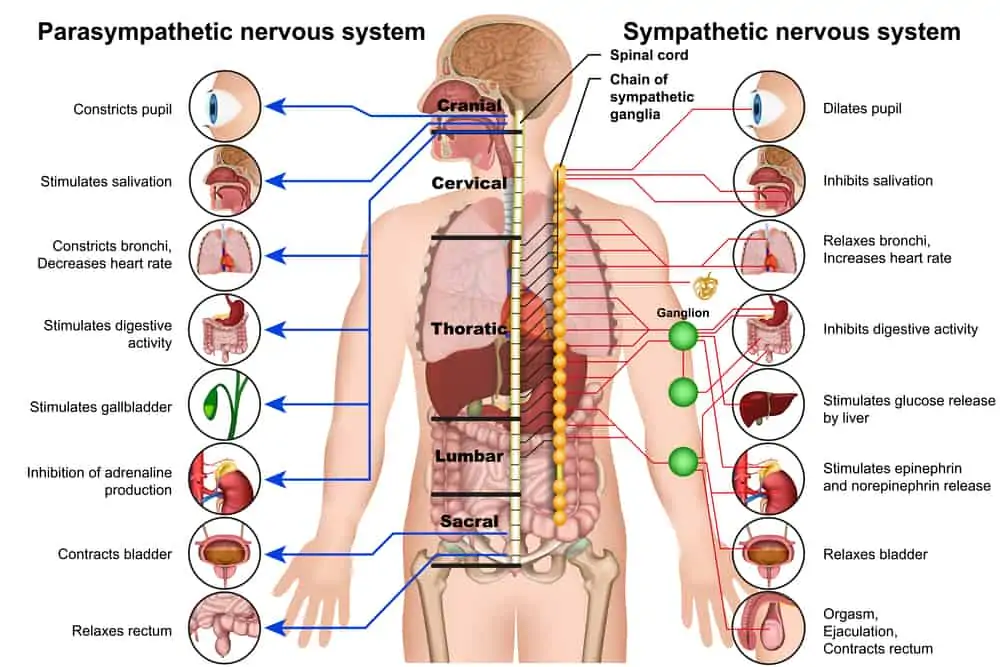
Whether it’s dodging Mario-Kart-like traffic or jumping to respond to every ding on your phone, our modern-day sympathetic nervous system tends to be “on” more than it should be.
I mean, a tiger isn’t chasing after you every time your iPhone pings – but sometimes that’s what it feels like.
When we spend too much time “on,” the system is overloaded with stress hormones and chemical mediators. This overload can perpetuate feelings of fear, anxiety, pain, and inflammation in the body.
Enter: deep breathing.
Deep breathing activates the parasympathetic nervous system and helps to decrease stress and anxiety to restore balance within the system.
The diaphragm muscle
With any mention of low back pain, the overwhelming response is to strengthen your core.
For the record, core strengthening is a rather loose term, and the effectiveness depends on the type and quality of exercises performed.
But the diaphragm is a core muscle that no one thinks about.
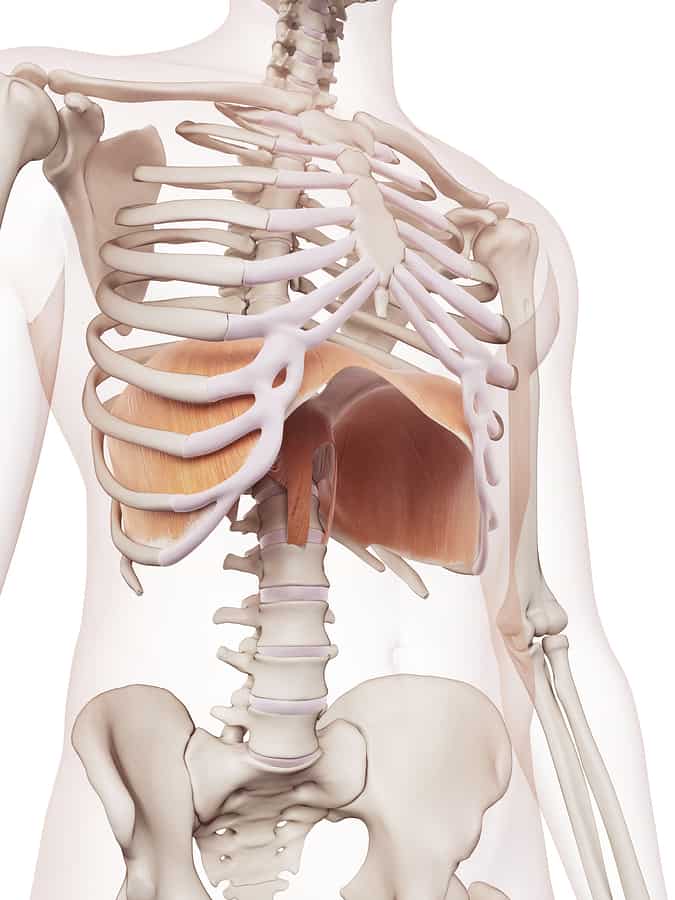
The diaphragm is a dome-shaped muscle that separates the chest from the abdomen.
When you inhale, the diaphragm contracts and flattens, moving downward to create more space and a vacuum-like effect for the lungs to fill with air. This contraction also compresses the core, increasing intra-abdominal pressure, which is why you feel like you’re stronger when you hold your breath (and exactly why you shouldn’t hold your breath).
There’s also a unique connection between the diaphragm and the pelvic floor, helping to regulate intra-abdominal pressure and maintain continence.
The vagus nerve
The vagus nerve is the longest cranial nerve that travels from the brain stem through the chest and abdomen.
Vagus nerve activity is modulated by breathing cycles. During inhalation, the vagus nerve is suppressed, and during exhalation, the vagus nerve is stimulated. (Gerritsen R et al., 2018)
The physical motion of the diaphragm muscle contracting and relaxing helps tone the vagus nerve.
Controlled deep breathing helps stimulate the vagus nerve and activate the parasympathetic nervous system, lowering heart rate and blood pressure to promote a more relaxed state. Shallow breathing or chest breathing triggers the sympathetic nervous system.
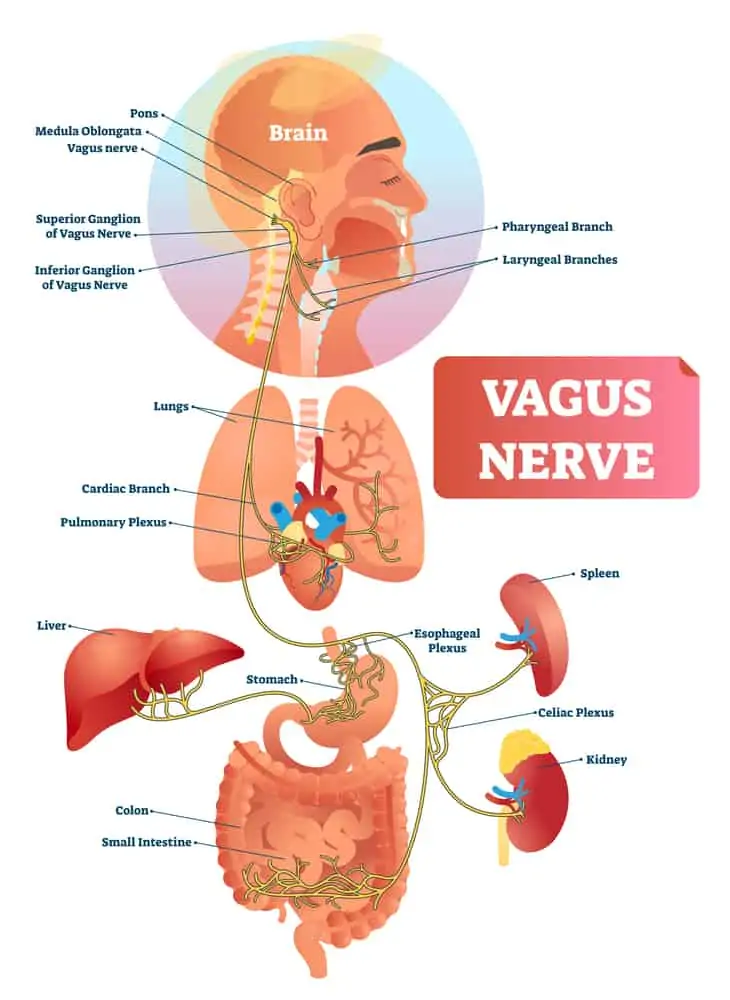
Easy breathing exercises for low back pain
So how can you take advantage of this natural nervous system hack?
These exercises are helpful for low back pain as well as any kind of pain or stress affecting your body.
As you perform these exercises, try to be mindful and present and notice the subtle sensations within your body.
Poor posture can also greatly affect your breathing pattern. Be sure to sit supported or lie down comfortably to maintain good posture while performing each breathing exercise.
Diaphragmatic breathing for low back pain
Diaphragmatic breathing is also known as belly breathing or abdominal breathing. It is a valuable technique that can improve sustained attention, affect, and cortisol levels in the body.
Diaphragmatic breathing exercises also help to develop proper breathing patterns and avoid compensating with the upper chest or neck muscles. It’s often taught in physical therapy as a starting point to integrate breathing and movement.
You can feel the difference in how much the rib cage moves when you focus on abdominal breathing.
How to perform:
- Sit or lie down comfortably, possibly closing your eyes
- Place one hand on your chest and the other on your belly
- Keep the lumbar spine relaxed (don’t try to flatten the back toward the ground.)
- Inhale deeply through your nose (if possible)
- Notice your belly rise and fall with each breath
- As you exhale, purse your lips and gently use your abdominal muscles to expel the air
- Try to lengthen your exhale to be at least as long as you inhale
- Perform for 5-10 minutes, use as needed
Box breathing
Box breathing is sometimes called square breathing, but the concept is the same.
This breathing pattern gives you something to visualize as you breathe.
How to perform:
- Sit or lie down comfortably, possibly closing your eyes
- Inhale for a count of 4
- Gently hold your breath for a count of 4
- Exhale for a count of 4
- Pause for a count of 4 before inhaling
- Repeat at least 4 times, use as needed
People are most uncomfortable during the pause before inhaling, but this improves with practice.
You can also increase the count to 5 or 6 seconds if that feels right for you.
Pursed lip breathing
Pursed lip breathing is another mindful technique to slow down your breathing rate and induce relaxation.
How to perform:
- Sit or lie down comfortably
- Inhale through your nose for a count of 2, 3, or 4
- Gently purse your lips as if you are almost trying to whistle
- Gently breathe out through pursed lips (not forcing the air)
- Try to lengthen your exhale to longer than your inhale in any count that works for you
- Repeat as needed
4-7-8 breathing
4-7-8 breathing is also called the relaxation breath. This rhythmic breathing technique is often used for anxiety and as a technique to get to sleep faster.
How to perform:
- Sit or lie down comfortably, possibly closing your eyes
- Inhale for a count of 4
- Gently hold your breath for a count of 7 seconds
- Exhale through pursed lips for 8 seconds, making a whooshing sound
- Repeat for 4 cycles, use as needed
Ujjayi breath
Ujjayi breath (Ujjayi pranayama) is a common breathing technique in yoga.
This calming breath helps lengthen the exhalation phase and makes a soothing rolling ocean wave sound.
Lengthening the exhale helps to tap into the relaxation response, activating the parasympathetic nervous system. Therefore, Ujjayi breath is beneficial on or off the mat.
Ujjayi breath can be a little tricky at first, but it’s a wonderful way to bring attention to your breath and relax once you get comfortable with it.
How to perform:
- Ujjayi breath can be done seated comfortably or during a yoga practice
- Inhale through the nose
- As you exhale, gently constrict the back of the throat with the mouth closed to make an ocean sound
- Focus on lengthening the exhalation phase
- Repeat as needed
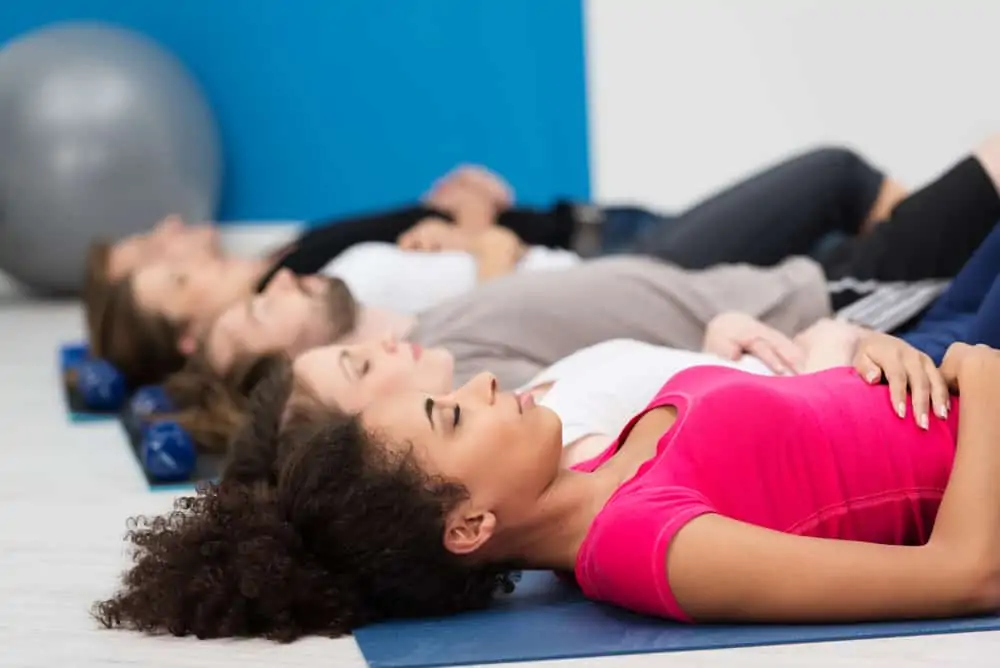
Inspiratory muscle training for low back pain
How can exercising your lungs ease pain in your back?
Inspiratory muscle training is a form of resistance training that strengthens the muscles used in breathing.
When respiratory muscles are weak, the body compensates with dysfunctional breathing patterns pulling in other muscles to help. Resistance training for breathing can improve lung function, endurance, and reduce compensatory patterns.
Inspiratory muscle training (IMT) is often thought of as a tool for improving breathing function after surgery or as therapy for respiratory conditions. Still, there may be benefits, including decreasing low back pain and improving athletic performance.
Ahmadnezhad L et al. looked at inspiratory muscle training in athletes with chronic low back pain.
The results were positive that IMT could improve respiratory function, increase core muscle activity, and reduce pain intensity in athletes with chronic low back pain.
This study only looked at muscle activity and pulmonary function and did not discuss the relationship between breathing and relaxation responses that can also positively affect pain.
While there were some limitations to this study, it’s certainly an interesting discussion. IMT can easily be done at home with minimal contraindications.
Inspiratory muscle trainers are available on Amazon and some are even geared toward specific populations like the Breather Fit Exercising Muscle Trainer For Athletes and the Breather Voice geared toward singers and public speakers.
As always, it’s best to check with your doctor or healthcare provider before adding this type of training in to your routine.

Yoga nidra for stress and pain relief
While it’s not exactly a breathing technique, yoga nidra is another tool to tap into deeper relaxation.
Yoga nidra is the yoga of sleep (you’re resting but not quite asleep). So it’s kind of like a guided meditation to take a journey through the body’s energetic layers through rotation of attention to different areas of the mind and body.
If that sounds a little woo-woo, stick with me.
A recent study showed that yoga nidra might be an effective method of facilitating physical, mental, and emotional relaxation, which are all complex components of chronic pain.
Before getting certified in yoga nidra, I had no experience with this practice. However, the first time I gave it a try, I was blown away at how relaxed and refreshed I felt. It was almost as if I’d just had a power nap after a 15-minute session.
It’s important to note that there are many different styles of yoga nidra, and some are more gentle than others. (Some types use polarizing mental imagery for desensitization, and this is not for everyone.)
If you want to try yoga nidra at home, I recommend Sarovara Yoga on YouTube. Her channel has many different length practices.
Anyone can do yoga nidra – no physical movement is required. Just put your headphones on and start relaxing!
Check out this article comparing three different styles of yoga for relaxation.
Wrapping up
Pain is tricky, and everyone responds to something different. Imaging often doesn’t tell the whole story, and there are many complex layers to pain management.
Deep breathing exercises are an easy and accessible way to work with your body naturally and improve your mind-body connection. They can be used on their own or in conjunction with other treatments.
Let me know which of these techniques is your favorite!
Don’t forget to check out How To Workout With Low Back Pain for tips to work around injuries while staying active.
References
Ahmadnezhad L, Yalfani A, Gholami Borujeni B. Inspiratory Muscle Training in Rehabilitation of Low Back Pain: A Randomized Controlled Trial. J Sport Rehabil. 2020 Nov 1;29(8):1151-1158. doi: 10.1123/jsr.2019-0231. Epub 2020 Jan 7. PMID: 31910393.
Ferreira-Vorkapic C, Borba-Pinheiro CJ, Marchioro M, Santana D. The Impact of Yoga Nidra and Seated Meditation on the Mental Health of College Professors. Int J Yoga. 2018;11(3):215-223. doi:10.4103/ijoy.IJOY_57_17
Hartz CS, Sindorf MAG, Lopes CR, Batista J, Moreno MA. Effect of Inspiratory Muscle Training on Performance of Handball Athletes. J Hum Kinet. 2018;63:43-51. Published 2018 Sep 24. doi:10.2478/hukin-2018-0005
Joshi B. Impact of yoga nidra as natural tranquilizer in emotional pain. Int J Health Sci Res. 2021; 11(4):156-169. DOI: https://doi.org/10.52403/ijhsr.20210422
Lorca-Santiago J, Jiménez SL, Pareja-Galeano H, Lorenzo A. Inspiratory Muscle Training in Intermittent Sports Modalities: A Systematic Review. Int J Environ Res Public Health. 2020;17(12):4448. Published 2020 Jun 21. doi:10.3390/ijerph17124448
Ma X, Yue ZQ, Gong ZQ, et al. The Effect of Diaphragmatic Breathing on Attention, Negative Affect and Stress in Healthy Adults. Front Psychol. 2017;8:874. Published 2017 Jun 6. doi:10.3389/fpsyg.2017.00874
Parker R, Madden VJ. State of the art: What have the pain sciences brought to physiotherapy?. S Afr J Physiother. 2020;76(1):1390. Published 2020 Feb 24. doi:10.4102/sajp.v76i1.1390
Vallath N. Perspectives on yoga inputs in the management of chronic pain. Indian J Palliat Care. 2010;16(1):1-7. doi:10.4103/0973-1075.63127
Waxenbaum JA, Reddy V, Varacallo M. Anatomy, Autonomic Nervous System. [Updated 2020 Aug 10]. In: StatPearls [Internet]. Treasure Island (FL): StatPearls Publishing; 2021 Jan-.
Zaccaro A, Piarulli A, Laurino M, et al. How Breath-Control Can Change Your Life: A Systematic Review on Psycho-Physiological Correlates of Slow Breathing. Front Hum Neurosci. 2018;12:353. Published 2018 Sep 7. doi:10.3389/fnhum.2018.00353


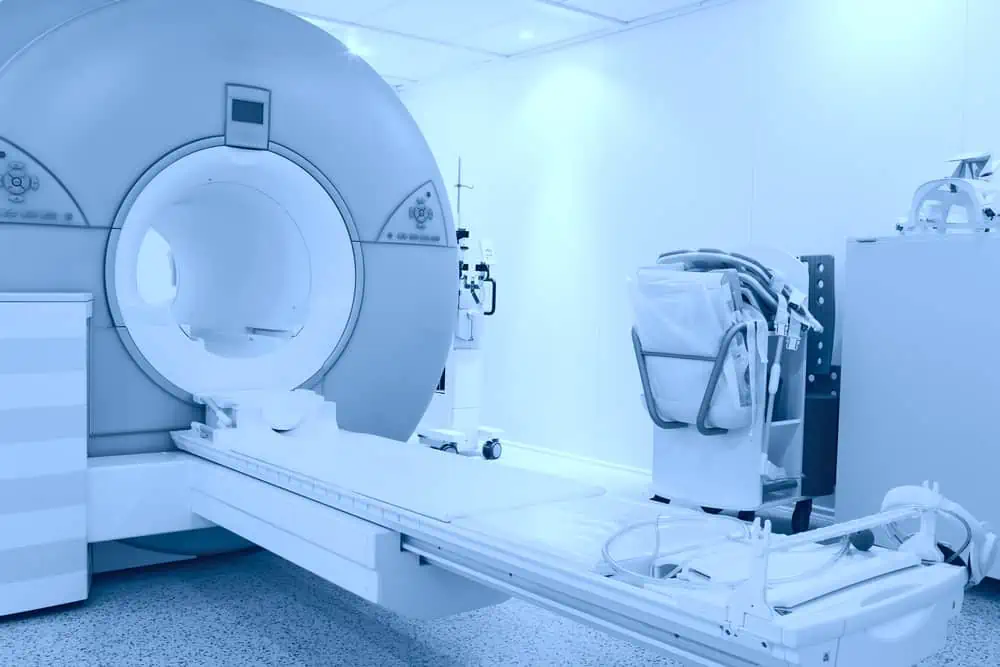



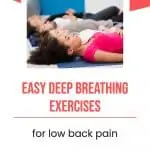

Im doing breathing exercises and didnt know there are variations, will try to follow this next time. Very interesting.
Yes, there are also more variations that I went into here. Thanks for reading.
This is such a great and informative post. I always have lower back pain so I can’t wait to try these techniques
I hope they’re helpful for you. Thanks for reading.
My husband just pulled a muscle in his lower back, I’ll have to show this to him!
Sorry to hear that, I hope these are helpful and he’s feeling better soon!